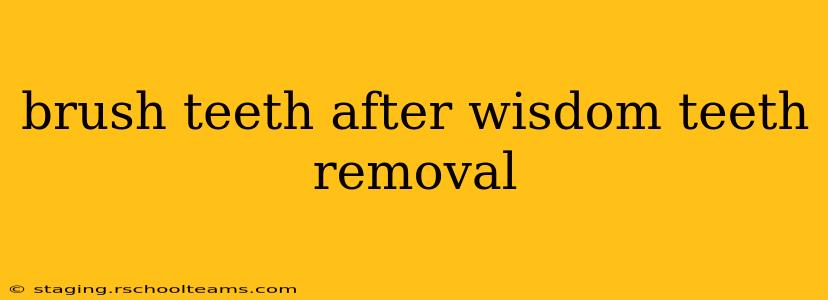Wisdom teeth removal is a common procedure, but knowing how to care for your mouth afterward is crucial for a smooth recovery. One of the most frequently asked questions is about brushing your teeth. This guide will provide you with the information you need to maintain good oral hygiene while healing.
When Can I Start Brushing My Teeth After Wisdom Teeth Removal?
This is a key question, and the answer depends on your specific situation and your oral surgeon's instructions. Generally, you'll be advised to wait until the bleeding has stopped and the numbness has worn off. This usually takes a few hours, but it can vary. Never rush this process. Aggressive brushing too soon can dislodge blood clots, leading to a painful and potentially serious complication called dry socket. Your surgeon will provide you with specific post-operative instructions, which you should follow diligently.
How Should I Brush My Teeth After Wisdom Teeth Removal?
Once your surgeon gives the go-ahead, gentle brushing is essential. Here's a step-by-step guide:
-
Choose a soft-bristled toothbrush: Avoid anything hard or abrasive that could irritate the surgical site.
-
Use a gentle technique: Brush with soft, circular motions, avoiding the extraction sites directly. Focus on the areas that aren't healing.
-
Rinse gently: Use a saltwater rinse (1/2 teaspoon salt in 8 ounces of warm water) to cleanse the mouth and help promote healing. Avoid forceful rinsing or spitting, as this could dislodge blood clots.
-
Be patient: It's normal to feel some discomfort or sensitivity around the extraction sites. Be patient and gentle with yourself.
What If I Have Stitches?
If you have stitches, be extra cautious when brushing near the surgical sites. Avoid brushing directly over the stitches. Follow your surgeon’s instructions carefully regarding stitch removal.
What Kind of Toothpaste Should I Use?
Use a fluoride toothpaste as recommended by your dentist. However, avoid using harsh whitening toothpastes or those with strong ingredients, especially in the initial healing phase.
How Often Should I Brush?
Brush your teeth twice a day, as you normally would, but maintain the gentle technique around the extraction sites.
What About Flossing?
Your surgeon may have specific advice about flossing. Generally, it's best to avoid flossing near the extraction sites until they have healed sufficiently. Focus on flossing other areas of your mouth to maintain overall oral hygiene.
What If I Experience Dry Socket?
Dry socket is a painful complication that can occur when a blood clot is dislodged from the extraction site. Symptoms include intense pain, a bad taste in your mouth, and a visible empty socket. If you suspect dry socket, contact your oral surgeon immediately. They can provide appropriate treatment.
Remember, consistent and gentle care is key to successful healing after wisdom teeth removal. Always follow your oral surgeon's instructions precisely and don't hesitate to contact them with any questions or concerns. Your post-operative care directly impacts your recovery and long-term oral health.
